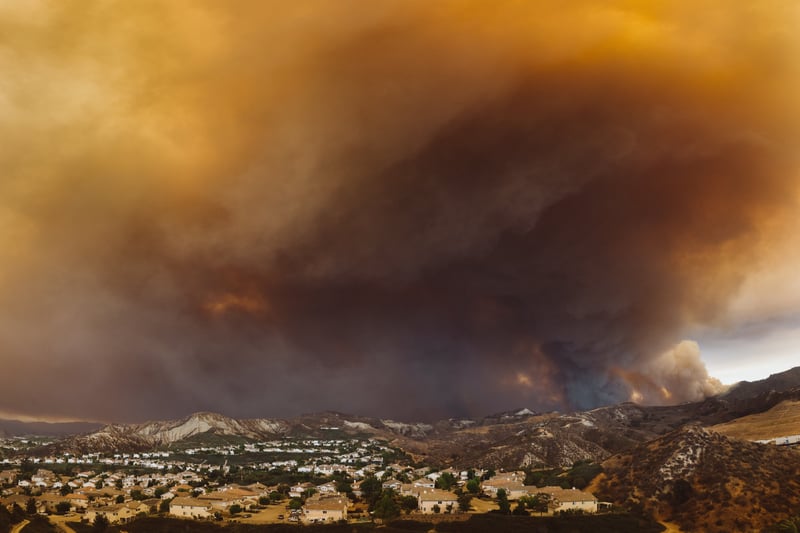Get Healthy!

- Steven Reinberg
- Posted August 25, 2023
Canadian Wildfire Smoke Caused Spikes in Asthma-Related ER Visits Across the U.S.
Smoke from Canadian wildfires sent high numbers of people suffering from asthma attacks to America's emergency rooms this spring and summer, according to two new reports.
From April 30 to August 4, 2023, smoke from out-of-control wildfires in Canada increased emergency room visits for asthma by 17% over average, according to data from the U.S. Centers for Disease Control and Prevention.
East Coast states, from New York down to Virginia, were especially affected, as were a swath of Midwest states including Illinois, Indiana, Michigan, Minnesota, Ohio and Wisconsin.
"These results highlight the need to reduce smoke exposure during wildfires and can help guide emergency response planning," said CDC epidemiologist Cristin McArdle, who led the study.
A second report focused on asthma-linked ER visits in New York state during the first two weeks of June when Canadian wildfire smoke blanketed the state.
On the worst day, June 7, levels of tiny airborne particles called PM2.5 rose to levels that were six times higher than average for western New York and 13-fold higher for people living in New York City. That study was led by CDC epidemiologist Haillie Meek.
PM2.5 are products of combustion and are a hazard for people with asthma and other respiratory and cardiovascular health conditions (including chronic obstructive pulmonary disease [COPD]), because they can lodge deep in the respiratory tract and even enter the bloodstream.
As McArdle explained, wildfire smoke is a mixture of air pollutants, small particles and hazardous gases. The mixture is formed from the materials being burned. That can include not only vegetation but buildings, plus a wide range of other materials depending on the location of the fire.
McArdle's advice: "People with asthma should be especially careful to keep track of air quality in their communities, reduce the amount of time they spend outdoors when the air quality is poor, keep the indoor air as free of wildfire smoke as possible, and pay close attention to health symptoms."
And, she added that "it's also important to have a supply of medicine ready in case anyone with lung disease, including asthma, begins to feel symptoms."
Dr. Albert Rizzo is chief medical officer of the American Lung Association. He believes the threat of wildfires to public health will only get worse.
"We're seeing more and more issues come up as we have climate change and more and more wildfires. We know that the flare-ups are not only for people who are sensitive, those with asthma and COPD, they are also causing people to have symptoms of cough and wheezing and end up using urgent care and hospital systems," Rizzo said.
"Patients with asthma or COPD already have inflammation as part of their condition," he explained. So exposure to PM2.5 particles and other pollutants "revs up inflammation, releasing more chemicals into the airway that cause the airways to tighten. That gives them the sensation of wheezing, shortness of breath and cough."
There are ways to mitigate the risk.
"Some of the things that I have my patients do is, first of all, have them become aware of checking air quality on a daily basis to help them plan their day," Rizzo said. "They may choose not to do some of the things outdoors that they would do on another day. That also may be the day when they realize they should close their windows and recirculate the air conditioner, use their HEPA filters." These patients are also the ones who if they have to go out, it "might be nice to have an N95 mask to wear to help on those bad days."
The two new CDC studies only covered emergency room visits, noted another expert, Dr. Jacqueline Moline. She believes there were likely many more people suffering asthma flareups during bad air days who went to their doctor or simply suffered through it. Moline is senior vice president for occupational medicine, epidemiology and prevention at Northwell Health in New Hyde Park, N.Y.
"Unfortunately, it seems like wildfires are increasing and they're becoming more widespread," said Moline, who is senior vice president for occupational medicine, epidemiology and prevention at Northwell Health in New Hyde Park, N.Y. "I don't remember ever having this kind of wildfire spread from Canada with the prevailing air flowing, but I think as everything's heating up and with changes in the climate we are going to see more people having asthma flareups."
The two reports were published Aug. 25 in the CDC's Morbidity and Mortality Weekly Report.
More information
For more on protecting yourself from wildfire smoke, head to the U.S. Centers for Disease Control and Prevention.
SOURCES: Cristin McArdle, PhD, epidemiologist, U.S. Centers for Disease Control and Prevention; Albert Rizzo, MD, chief medical officer, American Lung Association; Jacqueline Moline, MD, senior vice president, occupational medicine, epidemiology and prevention, Northwell Health, New Hyde Park, N.Y.; Morbidity and Mortality Weekly Report, Aug. 25, 2023




